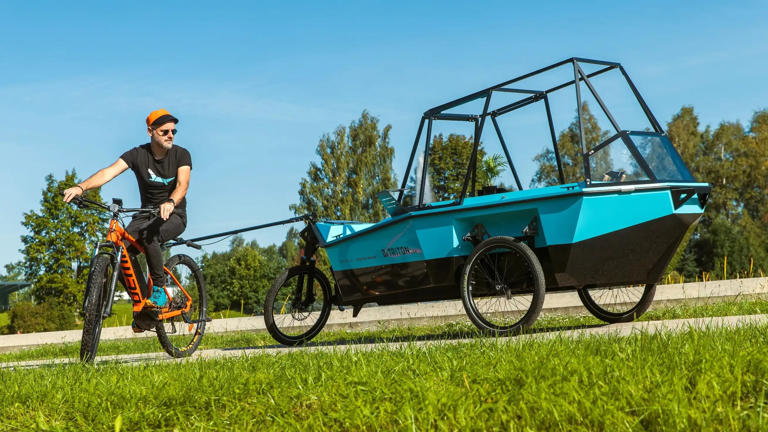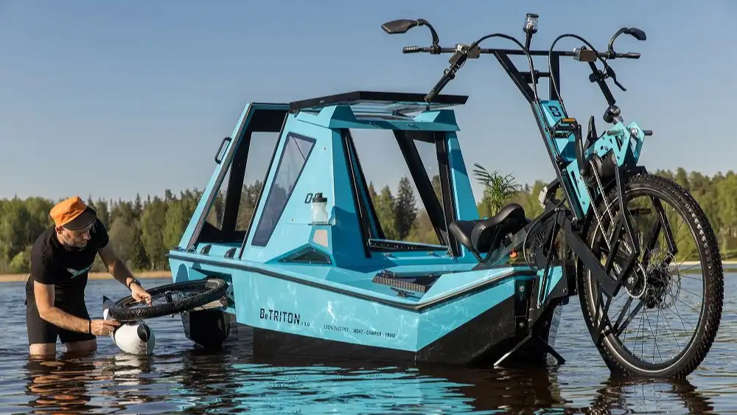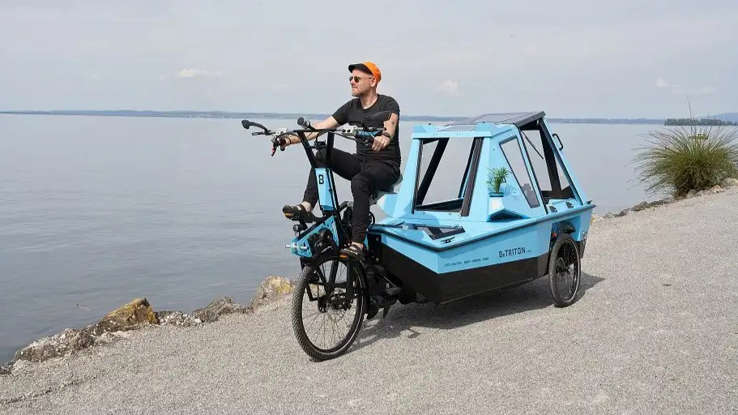New Mars Forums
You are not logged in.
- Topics: Active | Unanswered
Announcement
#151 2020-09-16 14:18:44
- kbd512
- Administrator
- Registered: 2015-01-02
- Posts: 8,302
Re: Bikes on Mars? - Don't laugh!
tahanson43206,
Is this going to be above or below ground?
If you expend the effort to create traffic tunnels, then why not use sealed pods and compressed CO2 like the system that the bank uses to transport money and paperwork in the drive-thru?
Offline
Like button can go here
#152 2020-09-16 17:20:58
- tahanson43206
- Moderator
- Registered: 2018-04-27
- Posts: 22,828
Re: Bikes on Mars? - Don't laugh!
For kbd512 re #151
Thanks for your question and your (to me very) interesting suggestion!
The below ground tunnels idea has been part of the My Hacienda concept since its beginning, but the idea itself may well go back far into the early years of the forum archive. That doesn't mean it will ever be implemented, of course, but it has precedent on Earth. Much of the infrastructure of older cities in Europe is built underground, and in the less ancient US, a city like New York has extensive underground infrastructure.
You are the first person I've seen suggest a "push" method of moving cars in underground tunnels. That is an interesting idea.
The usual (that I am familiar with) approach to that is to generate a vacuum to pull containers through a tunnel network.
Either method would work, of course, and I'd be quite interested in seeing an analysis of the pros and cons of each method.
The way you can tell you have a suction system is if you open the door to a port and it tries to pull you in << grin >>
We have digressed a bit from Bikes on Mars << grin >>
I was trying to stay on that lane with the follow on to your aerodynamic shaped passenger compartment.
(th)
Offline
Like button can go here
#153 2020-09-16 17:58:42
- SpaceNut
- Administrator
- From: New Hampshire
- Registered: 2004-07-22
- Posts: 29,722
Re: Bikes on Mars? - Don't laugh!
I am going to copy a few posts to the other topic which is geared more towards 4 wheel use versus just 2.
Quadricycle which covers the hybrid and other 3 or 4 wheeled motorized vehicles better suited for a mars tunnel use.
Offline
Like button can go here
#154 2020-10-16 12:34:31
- tahanson43206
- Moderator
- Registered: 2018-04-27
- Posts: 22,828
Re: Bikes on Mars? - Don't laugh!
For SpaceNut ....
The link to these YouTube videos showed up in one of the newsfeeds today ... I thought it might be of interest as a demonstration of operation in rough terrain:
https://www.youtube.com/watch?v=i4C0l8EXjto
The company that makes these appears to be in France.
(th)
Offline
Like button can go here
#155 2022-08-11 12:38:24
- Mars_B4_Moon
- Member
- Registered: 2006-03-23
- Posts: 9,776
Re: Bikes on Mars? - Don't laugh!
Safe?
Safety. Bike riding can be dangerous. Especially on rough unimproved terrain like on Mars. A fall or accident could damage the bike, potential stranding you. Or it could break a bone or damage your life support systems. All of these could be fatal. IMO the advantages of speed are more than outweighed by its dangers, slow and steady is the rule on Mars.
Back on Earth, the motorcyclist has less than two seconds to complete all safety measure all collision avoidance actions in an accident.
Fatality 5,579 per 8,317,363 registered motor cycles
https://www.iii.org/fact-statistic/fact … le-crashes
14% of road accident fatalities are motorcyclists
https://housegrail.com/motorcycle-vs-ca … tatistics/
Let's assume people riding bikes on the Moon and Mars will be going slower and moving safer.
Electric?
NASA has a plan for mini nuclear reactors on the moon which could one day power a lunar colony
https://uk.style.yahoo.com/nasa-plan-mi … 25584.html
This moon motorcycle concept by a Russian automotive designer is just wild
https://www.space.com/moon-motorcycle-concept-photos
Last edited by Mars_B4_Moon (2022-08-11 14:51:06)
Offline
Like button can go here
#156 2022-08-11 19:20:41
- SpaceNut
- Administrator
- From: New Hampshire
- Registered: 2004-07-22
- Posts: 29,722
Re: Bikes on Mars? - Don't laugh!
Not seeing much of a problem for mars tunnels since they could be pressurized such as to not need a space suit. Just wear a bicycle helmet and ride safely.
Important to remember is at some point we will go from pedaling to powered as resources are brought forward.
https://avt.inl.gov/sites/default/files … /power.pdf
How to GUIDE TO EV MOTOR CONTROLLER OPERATION & FEATURES
https://sterlinggtake.com/article/guide … es-part-1/
https://sterlinggtake.com/article/guide … es-part-2/
history of electric motors and how to control them
http://www.sunrise-ev.com/controllers.htm
Offline
Like button can go here
#157 2022-08-12 09:34:27
- Calliban
- Member
- From: Northern England, UK
- Registered: 2019-08-18
- Posts: 4,202
Re: Bikes on Mars? - Don't laugh!
In his book 'how to live on Mars' Zubrin discussed the use of motor bikes for exploritory missions from a Mars base. The idea was to use a hydrogen filled balloon, which would be pushed along by westerly winds to get most on the way. The explorers would release just enough hydrogen to bring the balloon to the ground and would tether it to a rock. They would then use motor bikes to explore, returning to the balloon to sleep in a tent-like hab. When exploration was done, they would release a small amount of stored H2 into the balloon, restoring its bouyancy, and use the wind to carry them back around the planet, returning to base when they were close enough to use their bikes.
The main problem I can see with bikes on Mars, is that much of the surface is covered by either loose regolith or rubble fields. Trying to bike over these would be tough.
Last edited by Calliban (2022-08-12 09:36:16)
"Plan and prepare for every possibility, and you will never act. It is nobler to have courage as we stumble into half the things we fear than to analyse every possible obstacle and begin nothing. Great things are achieved by embracing great dangers."
Offline
Like button can go here
#158 2023-02-21 03:51:14
- Mars_B4_Moon
- Member
- Registered: 2006-03-23
- Posts: 9,776
Re: Bikes on Mars? - Don't laugh!
The mini motorcycle that almost made it to the moon: NASA images show the secret project developed in case the Apollo lunar rover wasn't ready in time
https://www.dailymail.co.uk/sciencetech … -moon.html
NASA began testing Honda 90cc 'monkey bikes' in 1969
Offline
Like button can go here
#159 2023-03-11 13:33:42
- SpaceNut
- Administrator
- From: New Hampshire
- Registered: 2004-07-22
- Posts: 29,722
Re: Bikes on Mars? - Don't laugh!
I saw one of these designs being made use of by an employee at work that stated he has been using it pretty much all year when weather permits pedaling 4 mikes one-way each day. It has a small 20" tire hub generator that is 6V for the lighting needs.

I was a bit impressed too how far it was being used and wondered if the others were of similar mileage. We do have a few ebikes as well and I wonder if these were being used in a longer range or not.
Offline
Like button can go here
#160 2023-03-28 06:15:42
- Mars_B4_Moon
- Member
- Registered: 2006-03-23
- Posts: 9,776
Re: Bikes on Mars? - Don't laugh!
Bahamas a Unitary parliamentary constitutional monarchy.
The capital is Nassau on the island of New Providence.
People have trips, Big Money from tourist flights.
Tiny Island has Insane Traffic
https://www.youtube.com/watch?v=kdz6FeQLuHQ
Last edited by Mars_B4_Moon (2023-03-28 06:17:01)
Offline
Like button can go here
#161 2023-10-26 19:33:22
- SpaceNut
- Administrator
- From: New Hampshire
- Registered: 2004-07-22
- Posts: 29,722
Re: Bikes on Mars? - Don't laugh!
Have been looking at the wattage to motion for horse power required.
https://bikehike.org/ebike-how-many-cc-equal-w/
1000 watts/746 watts/hp = 1.34 hp. A typical fuel injected gas engine develops 1 hp per 22 cc. So 1.34 hp x 22 cc/hp = 29.5 cc. 1 hp = 746 watts
Offline
Like button can go here
#162 2023-10-27 07:18:52
- Calliban
- Member
- From: Northern England, UK
- Registered: 2019-08-18
- Posts: 4,202
Re: Bikes on Mars? - Don't laugh!
A problem I can see with bikes on Mars is the ruggedness of the terrain. Most images of the surface look like rubble fields. Trying to traverse that kind of terrain on a bike will be tough. You hit a rock at the wrong angle and you will come off the bike. It has happened to me before as a teenager. It put me off of rough terrain biking and I havn't done it since. This is less of a problem if you can build dirt track roads that are cleared of rubble. But bikes probably won't do well on unimproved terrain.
******
Additional: Some amazing bikes, quad bikes and velomobiles.
https://m.youtube.com/watch?v=8znCkm3BpPk
Some of these vehicles may indeed be nimble enough to handle the rugged terrain on Mars. Makes me wonder how far a man on Mars could go exploring with one of these lightweight electric quad bikes, with a inflatable tent and roll out solar array. Explorers could travel light.
Last edited by Calliban (2023-10-27 17:03:53)
"Plan and prepare for every possibility, and you will never act. It is nobler to have courage as we stumble into half the things we fear than to analyse every possible obstacle and begin nothing. Great things are achieved by embracing great dangers."
Offline
Like button can go here
#163 2023-12-20 15:11:30
- SpaceNut
- Administrator
- From: New Hampshire
- Registered: 2004-07-22
- Posts: 29,722
Re: Bikes on Mars? - Don't laugh!
This amphibious e-bike camper turns into a boat for aquatic adventures
It has a range of 25km (15.5 miles) with two batteries and a top speed of 8kmph (5mph), though as always, real world performance will depend on factors like terrain, weather, and how much you've piled inside. It has a maximum load capacity of 260kg including batteries, which BeTriton suggests you could use to haul passengers, bikepacking gear, and even your pet.
Not much for mars but might be for earth use.
The trailer version is a little more practical, letting you use your own e-bike and coming in a handy flat-pack kit that can be assembled with simple tools, much like Ikea furniture.
It's certainly not cheap, starting at €14,500 (about $16,000), but BeTriton also offers a rental service and will soon be opening its calendar for booking in 2024.
A bit of redesign we have a mobile home
Offline
Like button can go here
#164 2024-06-19 14:57:28
- SpaceNut
- Administrator
- From: New Hampshire
- Registered: 2004-07-22
- Posts: 29,722
Re: Bikes on Mars? - Don't laugh!
Hydrogen bike gets refueled in secs, offers 37 miles of range
HydroRide Europe’s (see more here) foldable, sport and rental hydrogen bikes are equipped with a 180-watt fuel cell, which helps the bicycles to produce electric current that propel them. They also come with two riding modes, presumably manual pedaling and hydrogen-assist riding. These hydrogen fuel-cell bikes can have a maximum speed of 23 kilometers per hour which may make them ideal for everyday commute and occasional adventures. For the foldable model, the bike can collapse in three steps, making it portable enough to be brought anywhere even if it weighs around 19.5 kilos.
One of the key advantages of HydroRide’s HYRYD bikes is the incredibly fast refueling time. Swapping hydrogen canisters takes only 3-10 seconds, providing riders with up to 37 miles (60 km) of range per canister. This convenience could be a game-changer, especially for those who use e-bikes for deliveries or frequent short trips.
https://www.designboom.com/technology/f … 6-18-2024/
With 200mL of water, the machine may be able to generate 20 grams of ‘green hydrogen’. This byproduct is injected into the removable water tank, which has a design resembling a water bottle. It can only take 3 to 10 seconds to fill up the tank, and the single refuel can give riders a range of 50 to 60 kilometers. The company also plans to distribute solar-powered charging stations, so riders can swap their empty tanks in less than 10 seconds.
https://electrek.co/2024/06/08/i-tested … he-future/
Those little hydrogen tanks, around the size of a 500 mL water bottle, hold enough hydrogen for around 60 km or 36 miles of riding.
To be honest, I guess that’s the point. Hydrogen isn’t meant to be some revolutionary game changer for performance. At the end of the day, the motor is still a basic 250W e-bike hub motor. And thus, the ride feels like a basic 250W e-bike.
Offline
Like button can go here
#165 2025-10-12 18:16:29
- quasar777
- Member
- Registered: 2002-05-05
- Posts: 138
Re: Bikes on Mars? - Don't laugh!
Hello Everyone
Offline
Like button can go here
#166 2025-10-12 18:51:10
- quasar777
- Member
- Registered: 2002-05-05
- Posts: 138
Re: Bikes on Mars? - Don't laugh!
Still after many yrs. Trying to find a link to the standup torso suit quadracycle for the moon. I dunno why it's hard to find.
Offline
Like button can go here
#167 2025-10-12 18:55:33
- quasar777
- Member
- Registered: 2002-05-05
- Posts: 138
Re: Bikes on Mars? - Don't laugh!
Found it maybe. I posted it in the first page here. Got ng back to 2002.
Offline
Like button can go here
#168 2025-10-13 06:49:16
- SpaceNut
- Administrator
- From: New Hampshire
- Registered: 2004-07-22
- Posts: 29,722
Re: Bikes on Mars? - Don't laugh!
Welcome back quasar777, long time....
I think you are talking about the chariot concepts.
AI Overview
NASA has funded the development of a concept for a "standing torso suit quadricycle for the moon" through a project called Chariot. Developed by a team at the Johnson Space Center, the Chariot is a multipurpose, modular lunar vehicle designed for astronauts to drive in a standing position, which gives it a "chariot-like" appearance.
Key features of the Chariot concept
Standing operation: The vehicle is specifically designed for astronauts to operate while standing, which allows them to explore more comfortably in their bulky spacesuits.
Modular design: The base mobility unit (chassis, wheels, batteries, and electronics) can be reconfigured with different attachments. These configurations allow it to serve multiple functions, such as transporting cargo, moving lunar soil (regolith), or carrying crew.
Hybrid operation: The Chariot is capable of multiple modes of control:
Onboard manual control: Direct operation by an astronaut on the vehicle.
Teleoperation: Remote control with small time delays from a lander or lunar habitation module.
Supervised autonomous control: Controlled from Earth with longer time delays.
Enhanced mobility: The standing position is intended to improve mobility for astronauts who are otherwise limited by the bulkiness of their spacesuits.
Broader lunar rover context
The standing torso suit quadricycle, or Chariot, is part of a larger effort to expand lunar mobility capabilities for the Artemis missions and beyond.
Replacing the original LRV: Like the Apollo-era Lunar Roving Vehicle (LRV), the Chariot is an unpressurized rover that will greatly expand astronauts' range and increase scientific productivity on the moon.
Supporting future exploration: In addition to crewed transportation, the Chariot is being developed to support cargo transport and other scientific objectives, including exploration of the lunar South Pole.
Complementing other vehicle designs: Other companies, such as Intuitive Machines and Lockheed Martin, are also developing unpressurized lunar terrain vehicles (LTVs). NASA has awarded contracts for the development and testing of several LTV concepts, ensuring a robust set of options for future lunar mission
Offline
Like button can go here
#169 2025-10-13 06:55:44
- SpaceNut
- Administrator
- From: New Hampshire
- Registered: 2004-07-22
- Posts: 29,722
Re: Bikes on Mars? - Don't laugh!
NASA's Chariot: Not Your Father's Lunar Rover
wow almost 2 decades ago.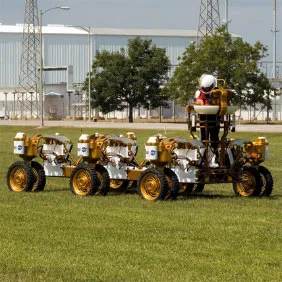
The specifications for Chariot were set forth as follows:
Chariot Spec Earth Prototype Lunar System
Payload 1000 kg 3000-6000 kg
Vehicle Mass 2000 kg 1000 kg
Top Speed 20 kph 20 kph
Range 25 km 100 km
Slope Climbing 15 Degrees 25 Degrees
Offline
Like button can go here
#170 2025-10-13 07:12:58
- SpaceNut
- Administrator
- From: New Hampshire
- Registered: 2004-07-22
- Posts: 29,722
Re: Bikes on Mars? - Don't laugh!
You may find some infor in these as well.
All-Terrain Hex-Legged Extra-Terrestrial Explorer (ATHLETE)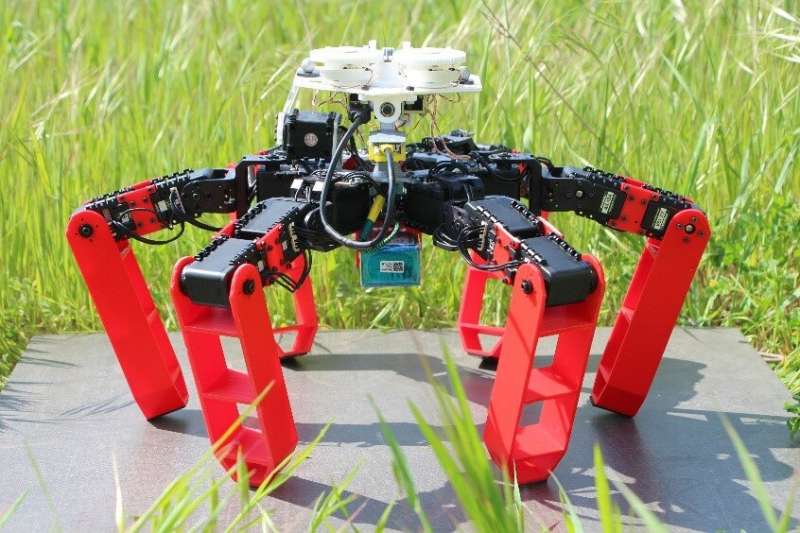
Topics that we had in that era are gone due to great crash.
Offline
Like button can go here
#171 2025-10-13 20:54:28
- kbd512
- Administrator
- Registered: 2015-01-02
- Posts: 8,302
Re: Bikes on Mars? - Don't laugh!
quasar777,
I think this is the basic concept, but this type of vehicle could be ridden while wearing a space suit:
Offline
Like button can go here
#172 2025-10-13 21:35:33
- kbd512
- Administrator
- Registered: 2015-01-02
- Posts: 8,302
Re: Bikes on Mars? - Don't laugh!
quasar777,
Perhaps you're thinking of the "Deus Ex Machina" concept created by Loniak Design for Yamaha Racing:
New Atlas - The Deus Ex Machina Wheeled Exoskeleton - new horizons in personal mobility - June 13th, 2008


Edit (a pic of the device without its rider / wearer):
This was the "techno-futurism" gadgetry that was supposed to power the above device:
Nano-phosphate batteries / ultra-capacitors for 15 minute recharge times (still a highly experimental tech)
Top Speed: 75mph; 0-60mph: 3 seconds (should be good for killing yourself quickly on the moon)
36 pneumatic "muscles" (presumably for steering of this "wearable vehicle")
2 linear actuators (presumably for adjusting ride height / angle)
Artificial "spine" with 7 "vertebrae" (presumably for weight shifting)
There's enough cool-sounding buzz-words strung together to satisfy the most discriminating keyboard motorcyclist. All of the above listed techno gadgets are technically real, at least as lab-ready concepts, and some do work to one degree or another, but not as part of a singular integrated vehicle design with exhaustive testing behind it, which would be a hard requirement for this "wearable" off-road ATV-like device to be used on the lunar surface for personal off-road transport.
Do I think it could work?
It probably could, but why not just design a proper dirt bike or ATV and call it a day? What significant benefits does this over-sophisticated device provide to its wearer, apart from a "flying / gliding sensation"? Is there any mass / volume benefit? I think the origami folding feature might save some space. However, looking cool and functioning reliably are two very different things. It's undeniably cool, but what would razor-sharp grains of lunar regolith do to all of its flexible parts? We should probably test that here on Earth, first.
Last edited by kbd512 (2025-10-13 21:46:03)
Offline
Like button can go here
#173 2025-10-13 21:47:35
- kbd512
- Administrator
- Registered: 2015-01-02
- Posts: 8,302
Re: Bikes on Mars? - Don't laugh!
quasar777,
How about a true "iron horse"?:
Offline
Like button can go here
#174 2025-10-13 21:51:32
- kbd512
- Administrator
- Registered: 2015-01-02
- Posts: 8,302
Re: Bikes on Mars? - Don't laugh!
Does anyone remember this wild-looking thing NASA created?:
Offline
Like button can go here
